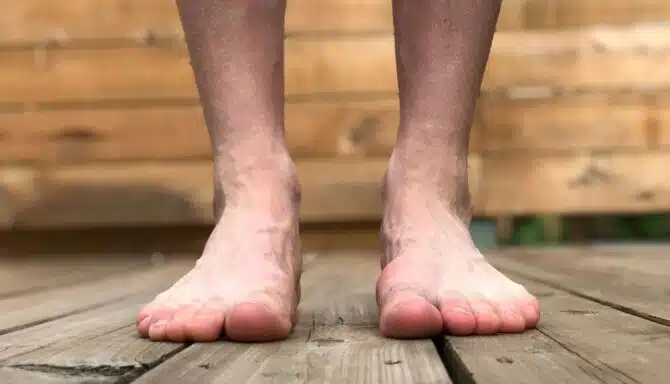Summer is prime time for ticks. Under all the greenery, wooded areas, and lush plants lie these tiny bugs that feed on blood. Ticks live on the ground, often in grassy and wooded areas, and latch on to their hosts (people, animals, pets) to get around. As our feet and legs are the lowest points to the ground, they’re prime targets for ticks.
Tick populations have grown in Ontario in recent years, in part due to the warming climate. Ticks survive in temperatures above freezing (0 degrees C). As the number of warm days increase each year, so too does the length of tick season.
Ticks are a real concern for outdoor enthusiasts and people who frequent the wooded areas of cottage country. Fortunately, a few simple measures can go a long way in protecting yourself from ticks and the diseases they can carry. These precautions start with your legs and feet, as they’re the connector between you and the ground where ticks live.
How Do You Get a Tick on Your Leg?
A tick can get onto your leg if you stir up fallen leaves or if you brush up against long grass. Through either direct or indirect contact, ticks can find their way onto your shoe or pant leg, and slowly move from there.
Generally, ticks are most active in the summer months. But, they can be found at any time of the year when the temperature is above freezing. Adult ticks are about the size of a sesame seed. But they can be as large as a grape. Ticks cannot fly. Instead, they move slowly on the ground or settle on tall grass. They can latch onto pets as well and bring them into the house, even if they’re not on you.
Why Should I Protect Myself From Ticks?
Protecting yourself from ticks is particularly important because of Lyme disease transmission. Lyme disease is a serious illness that can spread to people by the bite of infected blacklegged ticks. These are also known as deer ticks. According to the Eastern Ontario Health Unit, “A tick bite doesn’t always result in Lyme disease. A tick has to be infected with Lyme disease bacteria in order to pass it on to you. The risk of getting Lyme disease from a tick bite is believed to be greater if an infected tick has been attached to you for more than 24 hours.”
Symptoms of lime disease include flu-like illnesses, dizziness, headaches, muscle aches and fatigue. Some people also get a rash. Most cases of Lyme disease can be treated successfully with antibiotics. However, if left untreated, symptoms can last from months to years and can cause serious health problems.
Hence, protection and awareness are crucial.
What to Wear to Protect From Ticks?
How to avoid tick bites:
- Wear long pants and long sleeves: This can be more difficult in the summer, so wear moisture-wicking clothes top stay cool. Tucking your pants into your socks gives you bonus protection, as it seals in your legs and feet.
- Light-coloured clothing may make ticks easier to spot.
- Apply insect repellent containing DEET or icaridin and follow the manufacturer’s instructions.
- After spending time outdoors in wooded or bushy areas, shower to remove ticks before they become attached.
- Carefully check your full body and head for attached ticks.
- If you find a tick on your body, remove it as soon as possible.
- Remember to also check your children and pets for ticks.
Can Ticks Bite Through Socks?
Ticks cannot bite through socks or leggings. Hence, socks and leggings that cover the ankle area are the best line of defense to protect your legs and ultimately your body. Anything to cover exposed skin, like long pants, compression stockings, long socks, or socks tucked into pants, is beneficial.
If you want to bulk up protection even more, you can wear tick-repellent socks. Socks pre-treated with permethrin are a terrific way to keep these ticks from biting you. Throw your pants, socks, or leggings into the dryer when you come back inside to zap any ticks that may have made it into you. The intense heat kills them.
Wearing closed-toe shoes is also critical. Sandals are a no-go for walking in forested areas.
Are There Ticks in Toronto?

According to Public Health Ontario, “while low, there is a possibility of encountering blacklegged ticks almost anywhere in the province, provided the habitat is suitable for blacklegged ticks (e.g.: wooded or brushy areas).”
Blacklegged ticks have been found in Toronto, which suggests these ticks are becoming established here. An estimated 33% of Toronto’s ticks carry bacteria that cause Lyme disease. That said, the overall population of ticks in Toronto is low, which means the risk of getting Lyme disease in Toronto also low.
Toronto and the surrounding Greater Toronto Area is within the 2020 Ontario Lyme Disease Map. So is much of 401 corridor and Great Lakes region in southern Ontario, as well as Thunder Bay and Kenora. Outside these areas, there is a lower risk of ticks and Lyme disease.
Even though not all tick bites carry lime disease, they can still cause rashes, swelling and allergic reactions. They can also be an itchy nuisance.
What To Do If You Have a Tick on Your Leg?
To safely remove a tick from your leg:
- Use fine-tipped tweezers or a tick-removal tool. You can buy these from some pharmacies, vets, and pet shops.
- Grasp the tick as close to the skin as possible.
- Slowly pull upwards, taking care not to squeeze or crush the tick. Dispose of it when you have removed it.
- Clean the bite with antiseptic or soap and water.
Dog And Ticks
In Toronto, a city of 2.8 million people, there are roughly 230,000 dogs. Dogs are very susceptible to tick bites and tickborne diseases. The same diseases ticks pass on to dogs can be passed on to humans (although your dog cannot be the one who passes it along). Thus, it’s especially important to check your dog when out walking. Watch for tall grassy areas, forested patches and be sure to give your pet a good inspection when going inside.
Ticks often target areas that are hard for dogs to reach, like their back or nose.
Your Solutions Live Here!
All under one roof! Our team is trained to handle any and all foot concerns. From mild, to critical, we cover all sides of the foot needs spectrum. Call us to ask about actionable steps towards your solution today!
Call us at 416-769-3338 or Book Your Assessment Today!












